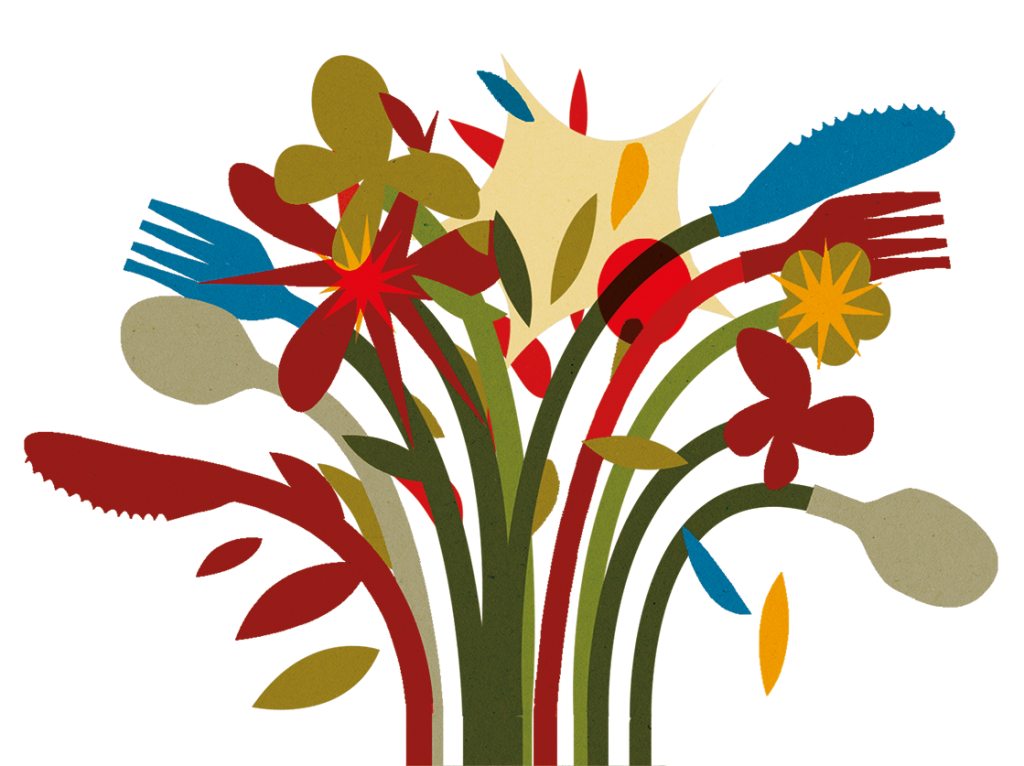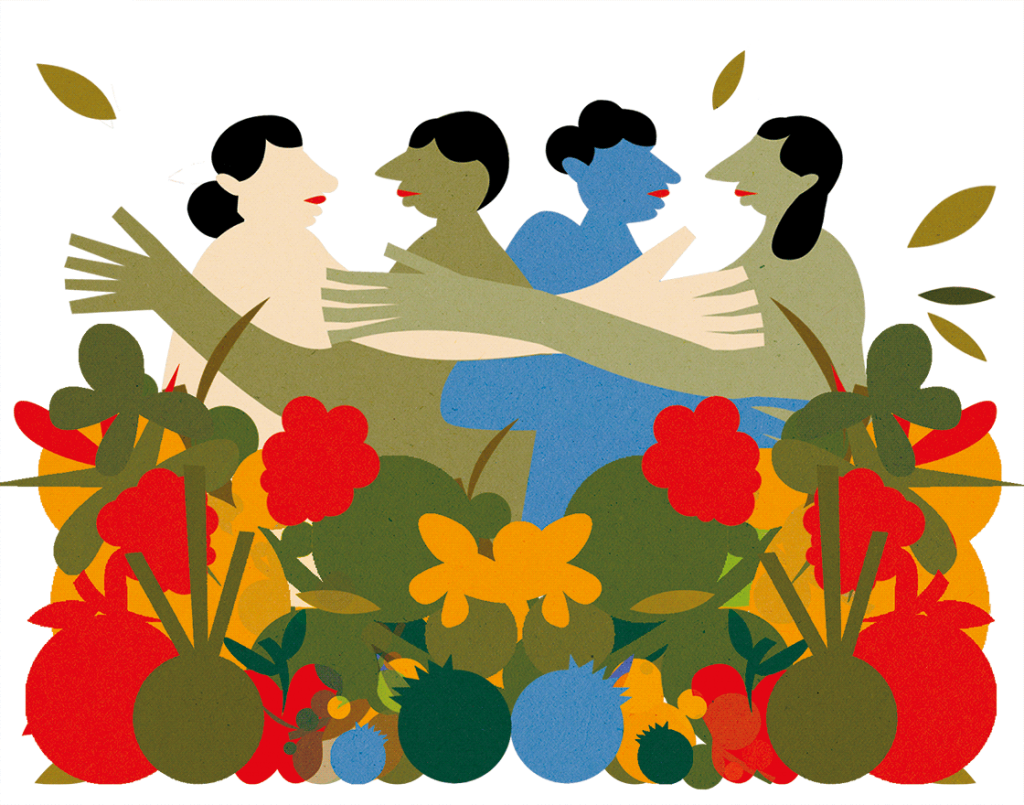Besiders
And I Will Make Nature My Home
In order to truly dwell in a place, writes Elisabeth Cardin in this essay from Issue 13 of the magazine, we need to be nourished by the foods that grow there.
Text—Elisabeth Cardin
Illustration—Chaimae Khouldi
Elisabeth, in Hebrew, means “God is my home.” When I was little, my parents chose to enroll me in an alternative school that taught ethics courses rather than catechism classes. I’ve never been able to recite a single Catholic prayer, and I never studied the story of Jesus or his Father or the Holy Spirit or Brahma or any other divinity. My family chose instead to teach me about art and nature.
Why hadn’t they named me after a landscape or natural phenomenon? Why not “Peaceful River,” “Friendly Forest,” or “Where the Moon Rises”? Why was God, whom I barely knew, chosen to be my home?
As I grew older, I came to understand that these two concepts—God and nature—are really one and the same thing.
My path through life has given me perspective on the many meanings people give to nature. Some people speak about “the universe,” others about “divine energy.” Whatever you call it, the idea stands for the force connecting the tangible world, our internal life, and some greater force beyond us. And home is the place, physical or figurative, where we allow this act of magic to occur.
—
What makes a home?
Issue 13 of BESIDE explores the home in all its diversity and beauty.
Get your copy today.Home is where we dry our boots
The first time I really got my boots dirty was in 2003, at the Montréal Botanical Garden, while studying ornamental horticulture. There were 15 of us in my class, and all we wanted of life was for it to amaze us with its botanical miracles; all we wanted of the earth was for it to teach us to become connected to each other.
And we did become connected. After two intense years of learning and friendship, we formed an extraordinary bond with the land. Somewhere in this academic undertaking, I developed a true obsession with edible wild plants.
During the few years following my studies, I practised foraging, without knowing where this meditative activity would lead me and without yet grasping the meaning that the edible flora of a place can carry.
Home is where we feed ourselves from the landscape
These roots that grew beneath my feet continued to spread. A decade after my studies in horticulture, I opened a restaurant, Manitoba, whose name means “the narrows of the Great Spirit.” It became the place where I spent the better part of my time for eight years.
From the very beginning, my team and I dedicated ourselves to local and seasonal foods. I’ve realized that beyond the economic and ecological effects of eating local, there’s a whole spiritual world, which is every bit as nourishing as the act of eating.

There’s a rich and silent communication between local food and the person who eats it: “I, too, am rooted here. I know what you need to adapt to this landscape, this climate, all these changes.”
Learning about the histories of what we eat means understanding the seasonal challenges that have shaped our diets, as well as all the richness of the land around us. Eating from nature can teach us everything about the land: the history of its First Peoples and that of waves of colonizers; its current demography and the equilibrium of its ecosystems; the composition of its waterways and soils.
You don’t have to live in the forest to become acquainted with its lessons; it’s enough to recognize its importance and choose what you eat. Nature, when you know it intimately, becomes the richest of teachers and the warmest of homes.
Home is where we drive in our stakes
When I was 34, I discovered for the first time the true story of the settlement of the land that is now called Québec, through Michel Lambert and his Histoire de la cuisine familiale du Québec, a monumental archival work chronicling 14,000 years of culinary traditions.
It’s an ancient history, written in whale blubber, seal meat, black crowberries, wild caraway, whitefish, capelin, tourtières, apple cider, sea urchins, brioche bread, beets, and rutabagas—an ancient story embroidered, interlaced, mixed, and told in Innu, Cree, French, English, Polish, and Arabic.
All these people and foods have one thing in common: they’ve lived in this place and fed their bodies and spirits on the same land.
They’ve made it their home.
Home is where we leave a light on
I’ve thought a lot about the idea of blending cuisines, how it reflects an openness to others, and how all of this is inflected by our colonial past and our conservative present. And I wonder if changing our relationship to nature through food could also help settlers develop a deeper understanding of First Nations people, and help those who’ve lived here for a long time to be more welcoming to people who arrive as immigrants.
Feeding ourselves from the land used to be a collective act. Many Indigenous peoples adapted their lives around foraging, hunting, and the changing seasons. Each food was celebrated and often embodied a divine spirit; it was respected, shared, and used to the marrow.

There was no question of taking more from the earth than it could provide: a powerful lesson that many of us have yet to fully learn.
We should never underestimate the importance of our relationship with the nourishing earth. One day in Montréal, my Algerian neighbour confided that in the 20 years she had been in Québec, she had never felt at home.
“What do you miss most about your country?”
“My grandmother’s garden, ripe fruits in the trees, the olive groves, the wild
herbs we would gather to season our dishes.”
“But do you know that the equivalent exists here too? You just have to learn.”
You just have to learn. I immediately regretted my reply. Historically, many immigrants became farmers, and this proximity to the earth and the communities they formed probably helped them grow their roots here. These days, many settle in large urban centres, where it’s difficult for anyone to feel a strong relationship to the land.
What would happen if we made local foods accessible, in the ways they were prepared throughout history? What if everyone learned to prepare meals with seaweed, seafood, fish, roots, and fruits? What if we reconnected with the seasons, and every neighbourhood and village church became a place of collective cooking, where together we prepared preserves from our harvest for the winter?
Together, we could craft a home where everyone belongs: a home where the doors are never locked, where the windows are open wide and the lights are on, ready to welcome each other with clarity and kindness.
Home is the place we decide to protect.
After the closure of my restaurant in 2021, I moved to the country and became a writer. I was approached by the Family Farmers Network to write a manifesto supporting, as they put it, the “multiplication of local, diversified, organic farms on the human scale.” To help “reconnect people to their land—and thus to a love of the resources that grow from the land, and the need to protect them.”
The need to protect them: these were the roots of my fascination. The desire to protect the earth has guided my life: it was woven through my time in youth clubs for the conservation of wildlife and flora, and animated the manifesto of the Family Farmers Network. It has also defined the contents of my pantry and the ingredients I used at Manitoba. I hope it will continue to guide me for a long time to come.
Nature, the places we visit, and the plants and animals we eat must be at the heart of our daily life and spirituality. Healing the place where we live is an act much more holistic and universal than we might think.
As in a village, where people are only happy if everyone takes care of each other, our world will only be at ease when we take care of the nature that surrounds us.
—
BESIDE POSTERS
Brighten up your home with one of Chaimae Khouldi's illustrations.
Purchase a signed posterElisabeth Cardin is an author (L’érable et la perdrix and Le temps des récoltes), visual artist, and a forager. Former co-owner of the restaurant Manitoba, she is interested in the ways we might weave relationships between the land and our kitchens.
Chaimae Khouldi is an illustrator and graphic designer based in Montréal. She is known for her bold compositions and her unique use of shapes and vibrant colors. Her approach combines light abstraction with clear, precise communication.
Never Miss Another Issue
Two issues per year
25% OFF previous issues
Free Shipping in Canada